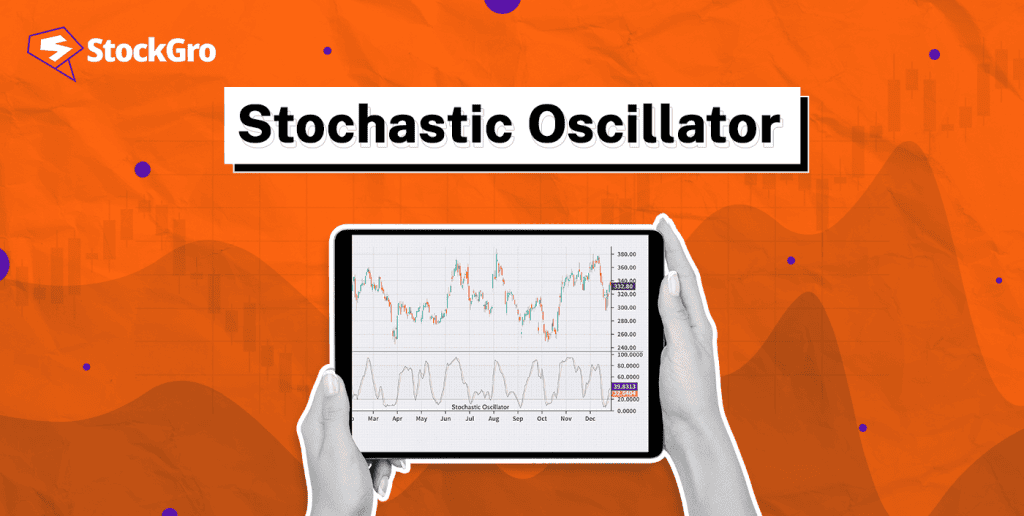
Momentum indicators help traders assess the speed of market movements. They track how quickly an asset’s value shifts and can hint at possible trend reversals. Having this knowledge is essential for determining when to transact.
One approach is to compare current market levels with previous ones. Doing so helps determine if the asset might be priced too high or too low, offering clues about future moves. While various tools are available, some are particularly favoured for their balance of ease and accuracy.
A well-known example is the stochastic oscillator. It’s trusted by many for its ability to spot potential market shifts. In the sections ahead, we’ll explore the stochastic oscillator and how to use it to sharpen your trading strategy.
What is the stochastic oscillator?
In the 1950s., Dr. George C. Lane pioneered the instrument. It is a technique that aids traders in determining how quickly a market is moving. It doesn’t simply follow trends in price or volume but focuses on the pace of market shifts instead.
The main concept behind this indicator is that momentum often shifts before an actual reversal takes place. By examining how current levels compare to past ranges, it identifies when the market could be at an extreme, signalling possible turning points.
Displayed on a scale from 0 to 100, the stochastics oscillator helps traders spot conditions where an asset might be nearing a peak or a trough. For better accuracy, this indicator is frequently combined with other techniques, such as moving averages or trendlines, to determine optimal entry and exit points in a trade.
Also read: Technical Analysis Tools in Share Market
How does the stochastic oscillator work?
The instrument calculates momentum by comparing an asset’s current near to its range across a predetermined number of days—5, 10, 14, 21, etc.—often 14 days. As noted earlier, it highlights the speed of price shifts rather than the direction itself.
- Range analysis
It calculates where the most recent close stands relative to the highest and lowest points during the selected period, giving insights into potential market extremes.
- Two lines at play
- %K line: Reflects the oscillator’s current reading.
- %D line: It is a moving average of %K (commonly 3 days), used to smooth out fluctuations.
A crossover between %K and %D, particularly in extreme zones, often signals a potential shift in market momentum.
- Both lines fluctuate between 0-100.
This indicator works best when combined with other techniques like trendlines or moving averages. Together, these tools can help traders time their entries and exits more effectively.
Stochastic oscillator indicator formula
The tool relies on two formulas, each serving a different purpose in tracking momentum. Here we are assuming the most commonly use 14 days period for %K and 3 days average for %D
- %K line formula:
%K = 100 x (CP – L14) / (H14 – L14)
Where:
- CP: The most recent closing price.
- L14: The lowest price over the last 14 trading sessions.
- H14: The highest price during the same 14-day period.
This calculation shows how close the latest closing price is to the asset’s 14-day range. It highlights shifts in momentum that might otherwise be overlooked.
- %D line formula:
The %D is a 3-day simple moving average or SMA of the %K.
Both lines are plotted together, allowing traders to spot crossovers and other key signals. While modern trading platforms calculate these automatically, understanding the formulas helps decode the deeper story behind price movements.
Stochastic indicator buy and sell signals
The stochastic oscillator operates on a scale from 0 to 100, offering insights into market momentum.
- Overbought and oversold zones
Values above 80 suggest the instrument might be overbought, meaning buyers are losing momentum. This crossover is often viewed as a cue to initiate a buy.
In contrast, a reading below 20 signals oversold conditions, where selling pressure may be fading. Traders frequently see this as a signal to think about selling or going short in anticipation of a decline in price.
These extremes are often considered early warnings of a possible price reversal.
- Price positioning
Readings between 50 and 80 show the instrument is in the upper portion of its recent movement, while numbers between 20 and 50 place it in the lower section. A shift above 50 frequently indicates that the asset’s direction has changed.
- Divergence signals
When the stochastics oscillator moves opposite to price, divergence occurs. For instance, if the market hits new highs but the indicator starts falling, it may signal weakening momentum. Similarly, a rising stochastic alongside falling prices could suggest a slowdown in the downward trend.
- Crossover signals
In the stochastic oscillator, when the faster %K and the slower %D lines meet, it often points to potential shifts in market direction.
If the faster line rises above the slower one, it may indicate that buying pressure is picking up. This can be a prompt to consider entering a long position, especially if it occurs in a low reading area (below 20).
When the faster line moves under the slower one, it can suggest declining strength in the market. Traders might view this as an opportunity to sell, particularly if the lines cross in a high reading zone (above 80).
- Bull/ bear signals
It is often used to spot both bullish and bearish trade opportunities.
In a bullish setup, the stochastic reading increases, while the asset’s value forms a lower high. This suggests underlying strength, with potential for upward movement. Traders tend to buy after a short correction, particularly if the oscillator dips below 50 and then begins to climb again.
In a bearish setup, the oscillator weakens, while the asset’s value forms a higher low. This indicates that selling pressure is growing, with the likelihood of a downward turn. Traders generally look to sell after a temporary price rebound, when the stochastic briefly rises but quickly reverses direction.
By interpreting these signals alongside other tools, traders can refine their strategies and better assess market conditions for potential trades.
You may also like: Here’s how you can use the MACD indicator
Limitations of the stochastic oscillator
- Unreliable in volatile conditions
In rapidly changing environments, the stochastic can suggest entries or exits too early, leading to poor decisions. Sudden price fluctuations often result in inaccurate signals.
- Misleading divergence
When price and the indicator diverge, it doesn’t always mean a change is imminent. Following divergence without further confirmation can lead to misguided actions and unexpected results.
- Struggles in strong trends
While useful for measuring momentum, the oscillator often stays in overbought or oversold zones during sustained trends. This can cause traders to miss extended moves or react too soon, assuming a reversal is near.
- Tightening limits may cause missed trades
Using more conservative boundaries, like 85 for overbought and 15 for oversold, reduces false readings but may cause traders to overlook key opportunities that don’t meet these stricter thresholds.
- Requires additional confirmation
Relying solely on this tool can be risky. Using it alongside other indicators, such as moving averages, offers a better perspective and helps filter out misleading signals.
Also read: What is EMA in the stock market?
Bottomline
The stochastic oscillator indicator is a useful tool for tracking market dynamics and identifying potential shifts in price direction. Its adaptability across various timeframes makes it popular, but it can occasionally mislead, particularly in fast-moving markets or prolonged trends.
To reduce the chances of acting on incorrect information, traders should use it in combination with other techniques. By doing so, one can better face the limitations and enhance decision-making for more reliable outcomes.
FAQs
- What does a stochastic oscillator tell you?
This tool compares the latest close to the asset’s range over a set period. It highlights potential shifts in market strength, signalling when conditions may be overbought or oversold. A figure above 80 suggests a downturn could be nearing, while a result below 20 hints at a possible upward move. Traders watch for these levels to anticipate changes in direction. It’s more effective when paired with other methods to confirm its indications.
- Which is better: RSI or stochastic?
Some traders prefer Relative Strength Index for trending conditions, as it helps highlight when an asset is overbought or oversold. On the other hand, the stochastic oscillator tends to be more effective in choppy or sideways movements, showing shifts in momentum. Each tool has its advantages based on the situation. Many combine both to confirm signals, allowing for more informed decisions. Ultimately, the best choice depends on what suits your trading approach.
- What is the meaning of stochastic 14-3-3?
Stochastic 14-3-3 refers to specific settings in the stochastic oscillator. The “14” looks at the last 14 periods to calculate the initial momentum. The two “3”s apply smoothing: one to the main value and the other to the signal, which is an average of the main reading. These settings help filter out market noise and generate clearer signals for traders.
- What is d and k in stochastic?
In the stochastic oscillator, %K measures where the asset stands within its recent high-low range. It reacts quickly to fluctuations. %D is a slower-moving average of %K, smoothing out short-term changes. Traders rely on %D for more stable readings. When %K crosses above or below %D, it suggests potential shifts in market momentum, helping traders decide when to buy or sell. Both lines together give insights into possible trend reversals.
- Which indicator is best for trading?
The right indicator depends on how you trade. Moving averages are great for tracking trends, while RSI is better for identifying extreme price levels. Stochastic is useful for spotting shifts in momentum. Each has its advantages, but no single one applies to all situations. Many traders combine several indicators to get a clearer sense of what’s happening. It’s about choosing what aligns with your strategy and the current conditions.

